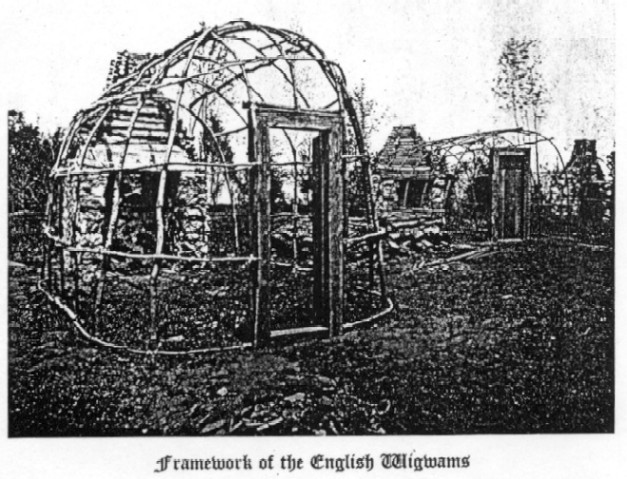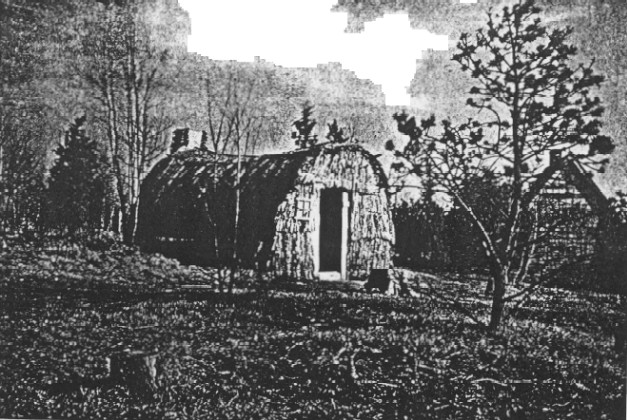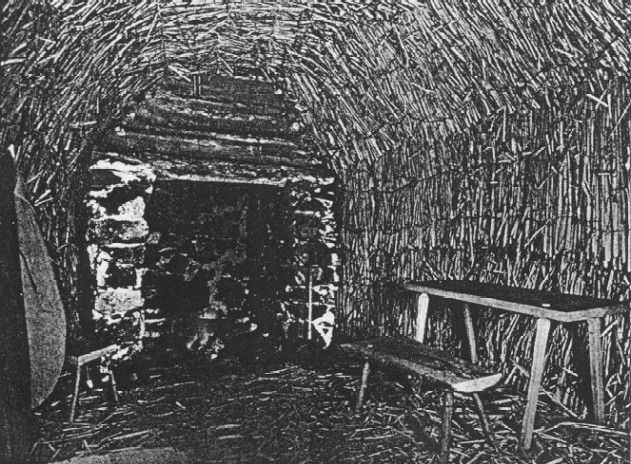
The first settlers in the Massachusetts Bay brought
with them mechanics of all kinds, well equipped with tools and it is altogether
probable that these workmen plied their trades on this side of the Atlantic
exactly as they had been taught through long centuries of apprenticeship
in England. The houses of that early period, still remaining in Massachusetts,
all resemble similar English structures. Upon arrival, the need for shelter
was imperative, and all sorts of rude expedients were adopted. John Winthrop,
in his Journal, writes that "the poorer sort of people (who lay long in tents)
were much afflicted with scurvy and many died, especially at Boston and Charlestown."
He also makes several references to English wigwams. In September, 1630,
one Fitch, of Watertown, had his wigwam burned down with all his goods and
two months later John Firman, also of Watertown, lost his English wigwam.
Edward Johnson, in his Wonder-Working Providence,
mentions the rude shelters of the first settlers. "They kept off the short
showers from their lodgings, but the long rains penetrated through to their
disturbance in the night season, yet in these poor wigwams they sang Psalms,
praise and pray their God till they can provide them homes which ordinarily
was not won't to be with many till the earth by the Lord's blessing brought
forth bread to feed them, their wives and little ones."
The Rev. Francis Higginson, in his New-Englands
Plantation, printed in 1630, describes the wigwams built by the Indians
living at Salem as "verie little and homely, but made with small poles prick't
into the ground and so bended and fastened at the tops and on the side, they
are matted with boughes and covered with sedge and old mats." It seems likely
that when the English built themselves "English wigwams," they copied the
small structures built by the Indians, especially as mats suitable for covering
might be obtained from the Indians by barter, and old pieces of sailcloth
doubtless might be obtained from the shipping stores. It seems unlikely that
an Englishman living in one of these structures during the winter season
would be content to allow the smoke from his fire to find its way out through
a hole in the roof in the Indian fashion. It is more likely that a fireplace,
built of stones or bricks, would be constructed at one end of an "English
wigwam," and this was done in the present structures. A door in hewed frame,
with wooden hinges, also has been installed as a suitable substitute for
the Indian mat lifted upon entering. The floors in these wigwams have been
covered with rushes and straw, following the custom in English cottages at
that time. The historian of Lynn, writing a century ago, records that the
first settlers in that town made a shelter for themselves by digging caves
into banks of earth, and the historian of Concord, Massachusetts, records
that early settlers in that town dug cellars in the earth which they spanned
with wooden spars and then covered with turf. In such shelters the first
settlers in Massachusetts lived until they were able to build frame houses
in which to shelter their wives and children.

An English Wigwam covered
with mats made of rushes.
For a century or more it has been assumed by historians
that the early settlers, upon reaching New England, proceeded to erect log
cabins of the type built by the woodsmen on the frontier at a later date.
As these Englishmen had never seen a log cabin and such a structure was unknown
in England, it seems unlikely that upon reaching the Massachusetts Bay they
invented a type of building hitherto unknown to them. Moreover, when the
Pilgrims landed at Plymouth, they at once proceeded to dig saw pits and to
saw boards precisely in the same way they had been doing in England for many
generations. The ship Ann, arriving at Plymouth in the summer of 1621, was
loaded in a short time, for the return voyage, with boards and furs. It is
unlikely that the Pilgrim neglected to provide shelter for his children before
shipping sawed boards to England. The records of the Massachusetts Bay Company,
still in existence, show that saws and all kinds of tools were in the ships
that arrived at Salem, and undoubtedly one of the first things done was to
dig saws pits and set men at work sawing up boards to use in the construction
of buildings.
Several of the chimneys on the houses in this colonial
village are built of wood. This follows the usage in the early days when
bricks at the outset were difficult to obtain. Thomas Dudley, writing to
the Countess of Lincoln, in March, 1637, relates: "We have ordered that no
more shall build chimneys of wood nor cover his house with thatch, which
was readily assented to for that divers houses have been burned, the fire
always beginning in the chimneys, and some English wigwams have taken fire
in the roofs with thatch or boughes." The first meetinghouse built in Salem
had a "catted" chimney, that is, the chimney was built with sticks laid cobhouse
fashion and the whole daubed with clay inside and out. The walls of some
of the early houses were "wattled and daubed" in the English manner, and
an example of wattle construction may yet be seen in the gable end of the
Fairbanks house at Dedham. Bradford, in his History, mentions the
destruction by fire of a shed, the walls of which were "wattled up with boughes."
In several of the houses in the present Salem village, and also on the wigwams,
may be seen examples of "catted chimneys."

Interior of an English Wigwam
Thatch as a roof covering has been alluded to. This was common in the early days. Notwithstanding the fact that the Great and General Court forbade its use, it still persisted as necessity arose. At the outset, towns along
Continued on Page 3.
Back to Page 1.
Back to Winthrop Fleet and John 1
Bigelow.
Back to Winthrop History
Information on these pages provided by:
Gerald G. Johnson, Ph.D.
648 Salem Heights Avenue, So.
Salem, OR 97302-5613
![]()

